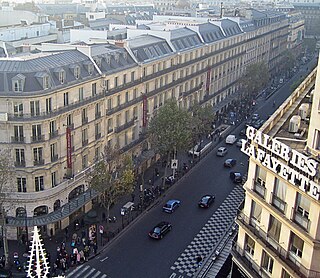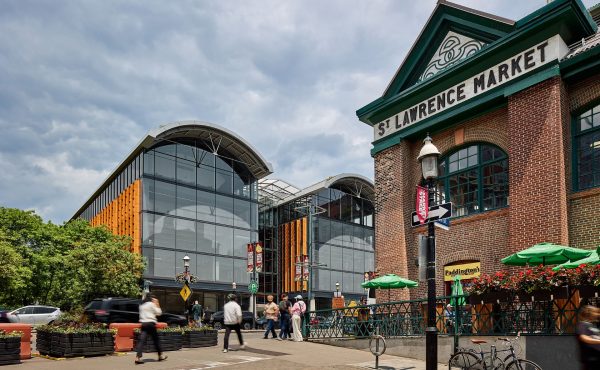I’m not always on exactly the same page as the Star‘s architecture/urban critic Christopher Hume when it comes to individual buildings, but I like the way he thinks about the big picture.
In today’s paper, his column made a deeply important point that I’ve felt has been overlooked for a long time: It’s the vernacular, everyday architecture that makes a city.
What is a city, after all, but an inhabitable infrastructure? Torontonians must stop looking for the quick fix — the Olympics, the World’s Fair, whatever. They are not the answer. In fact, given the way we approach development, they would likely lead to even more damage.
It’s time to think small, one building, one park, one garden, one schoolyard, one corner, one streetscape at a time, not to drown the city in what Jane Jacobs termed “cataclysmic money.” That we don’t need.
 Here’s what I would add. People often look to flashy super-projects, such as the ROM or OCAD, to make Toronto more interesting and sophisticated. But if you look at cities visitors love, it’s not a flashy building — the Centre Pompidou in Paris, the Guggenheim in New York — that makes the city. It’s the fact that you can walk and walk for miles and all the ordinary, practical buildings are attractive and form a great urban environment. It’s a depth of building quality that makes a city.
Here’s what I would add. People often look to flashy super-projects, such as the ROM or OCAD, to make Toronto more interesting and sophisticated. But if you look at cities visitors love, it’s not a flashy building — the Centre Pompidou in Paris, the Guggenheim in New York — that makes the city. It’s the fact that you can walk and walk for miles and all the ordinary, practical buildings are attractive and form a great urban environment. It’s a depth of building quality that makes a city.
Hume and I might disagree on a few of the more interesting houses, condos and office buildings that have been built in the last two decades in Toronto, but we would agree on about 75% of all the new buildings in Toronto: they are crap — dull, thoughtless, and unconnected to the city around them. There are definitely some exceptions, but we notice them because they’re exceptions. They shouldn’t be exceptions — they should be the norm.
This is a really important issue because the city’s current development plan is to intensify the city’s main streets and turn them into “avenues” that will be the shape of the new city. But if the buildings that go up on these avenues are dull, generic, monolithic and do not connect with and frame the street, then Toronto will be little better off than it was before, still reliant for its attractive areas on those neighbourhoods built before the middle of the twentieth century.
We need to make NEW attractive, effective streets and neighbourhoods, too, and to do that, we need to make a real effort. The city needs to set an example in the work it does itself (streetscapes, public buildings, parks), and we — the city and its citizens — need to learn to demand a real effort from private developers. New buildings — ordinary ones such as houses, condos, retail — can’t just be vaguely acceptable. They have to be good. The current situation is not good enough.




8 comments
Jane Jacobs was saying this kind of thing 40 years ago and we still haven’t learned.
Hear hear.
it’s not fair to shoulder the blame on developers when it’s the city that is responsible for the shabby state of our streets (which form a large part of the public realm); ie cheap concrete sidewalks covered in asphalt patches, run down poles everywhere, hydro wires strung along almost every street in the city. Note also that the improving street furniture initiative will not fix any of these things.
As long as we put pedestrians before cars, this city will be a real treat no matter how craptacular our architecture/cityscape is. For example, Dundas street between Bathurst and Ossington is one of the ugliest strips of urban commercial real estate I can think of and, yet, the intimate pedestrian feel of it is leading to the creation of one of the city’s best neighbourhoods.
In the Bronx, the Grand Concourse was a tree-lined boulevard designed with striking art deco apartments that were all scaled like Parisian blocks but it quickly degraded into a ten-lane highway. Today it’s a total washout to everyone except die-hard architecture enthusiasts. It sucks to walk down that street.
I agree with the general sentiment, but it’s inordinately difficult to make highrises (condos and office towers) fit in — by their very definition, they won’t. Any attempt to pay attention to detail is bound to be lost to the budget when that detail is multiplied by dozens of floors.
We should first be paying attention to *what* we are building rather than how we are building it. A boom in the construction of highrises is just going to turn Toronto into Vancouver — an anonymous wall of steel and glass.
Look at zoning in Toronto. YOU CANNOT BUILD PARISIAN OR LONDON STYLE 5-7 STORY APARTMENT BLOCKS.
Too “dense”, no set backs, etc.
THIS IS ALL YOUR FAULT SPACING. YOU AND YOUR PRO-ZONING, PRO REGULATION MINDSET.
Stop council from forcing developers to build crappy towers in the park. Stop protecting towers in the park as “historical”. Lets get development right to the edge of the sidewalk, everywhere. London is great and doesn’t have these crappy parkettes that our city is so enamored of. There are squares (many owned by surrounding residents) that are taken care of and viewed as part of the community. The crap that council mandates sucks and perpetuates the disaster that is the city of Toronto.
Obivously “Hey” knows squat about what makes a good city. Maybe he wants to live in LA or Houston where there are no rules to development. The zoning rules are the only thing that has made TO decent — without them we would end up with Las Vegas and other bullshit development, all in the name of what is good for the developer with no eye towards what is good for residents.
And Hey seems to like to hide behind an anonymous posting. I love it when people are willing to shoot their mouth off but not have the guts to attach their name or website to the comments.
“Hey” also knows squat about zoning in Toronto. The King-Spadina and King-Parliament areas were specifically zoned by council as he describes – 7 storeys, have to go to property line, mixed use. The result has been a revitalization of these areas and quite a few good buildings, although of course developers have started to get greedy and push for more and more storeys — which goes to show that this approach is not what developers would naturally build, hence the need for zoning. And this concept is specifically what the “Avenues” concept in the official plan calls for.
Also, of course, he’s missed the point. The point of this post really isn’t the zoning of the buildings, it’s the effort put into their design. Generic slapped-up buildings won’t make all that great a city, even if they fit this ideal.